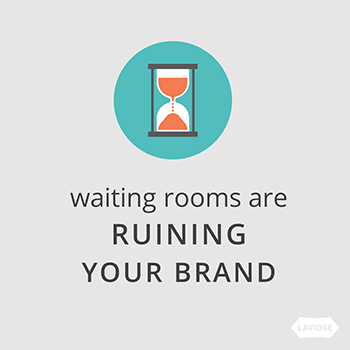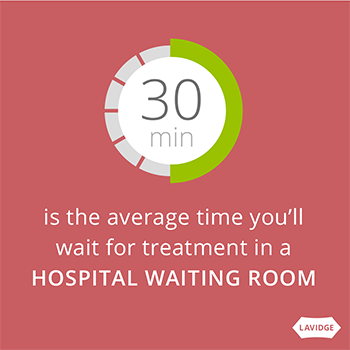Sign up for our LAVY email
and get our bi-monthly newsletter.
Your patients are on to you. 
Your hospital, practice or lab facility spends significant resources on content marketing, advertising and public relations. Your website is a work of art. You say that your facility is high touch and patient centered.
But your marketing promises dissipate when a patient walks in your door. There is a great divide between what you say you stand for and what you actually deliver. This lack of follow-through in the customer journey is what can doom your brand.
This is especially true for medical and other healthcare professionals. You’ve observed it firsthand. You might choose a hospital or physician because of their marketing. You admire their TV commercials, billboards and sponsorship of community health and wellness events. But your experience fails to live up to your expectations. The waiting room is a throwback to the 1970s. It takes too long to see a doctor. The staff appear to have never been briefed on the concept of customer service. As a result, you broadcast your unhappiness on social media. You tell your friends. And that satisfaction survey you received? Time to vent.
This problem isn’t suffered solely by healthcare companies. The separation between brand activities promoted by marketing campaigns and day-to-day operations is rampant throughout many industries. Poor service or customer experience can hurt any business. That results in losing customers and referrals. But hospitals, for example, can suffer additional financial punishments and public embarrassment.
An element of the Affordable Care Act is a federal program that measures every hospital’s quality of care. Part of this evaluation is conducted through the Hospital Consumer Assessment of Healthcare Providers and Systems (HCAHPS) patient survey. Head over to the Medicare.gov website and you can compare hospitals in your market, which are publicly rated on a one- to five-star ranking. As if getting a two-star rating isn’t shameful enough, the government can also withhold 2 percent of a hospital’s Medicare reimbursements if patient satisfaction is too low. On the other hand, facilities doing a great job at making customers happy can earn bonuses.
Are healthcare companies incentivized to improve the patient service? You bet.
 Hurry up and wait
Hurry up and waitThe biggest predict of patient dissatisfaction is waiting. Wait to get through the registration process. Wait to see a doctor. Wait to pay your bill or get discharged. Simply put, as wait time goes up patient satisfaction goes down. We know this instinctively and studies have proven it.
But wait time is all about perception. Some hospitals and physicians have made attempts to alter the waiting experience. When they succeed, patient satisfaction is greatly improved even though the actual waiting time hasn’t gone down. If a patient is occupied while they wait, time seems to go faster. When a patient is more comfortable in the environment—if they truly experience the brand promise—then customers will give the institution high marks despite clinical outcomes.
Some of the elements being used to foster synched branding while waiting are:
The concept is simple: Present a homelike atmosphere so people feel instantly comfortable and welcomed. Give them things to do and provide choices. Remember: your waiting room and reception area demonstrates who you are. If your office is disorganized, dingy and old, then patients believe that they’ll be treated the same way and that their clinical care will suffer. Your facility’s physical environment directly impacts the patient experience and communicates the core of what your brand represents, and it affects the perception of quality of care.
By the way, a shining brand-aligned facility will also rub off on your employees, who will be happier, too. Studies have shown that happier staff create a healthier customer experience.
But such design essentials only go so far if you’re still wondering when you’ll be called. A great deal of anxiety surrounds not knowing when it will be your turn or if you’ve been forgotten. This causes patients to experience anxiety and anger.
Healthcare brands that are truly focused on the customer experience in real life in addition to UX on their website, are employing a number of methods to make waiting patients feel better. One of the more successful tactics is hiring a dedicated waiting room attendant, whose duties revolve around continually checking in with those who are waiting. It’s true that your employees are your brand. The experience also is the brand. A waiting room attendant is a physical embodiment of your company. It shows you care. And, by the way, that will raise your customer satisfaction scores.
Hospital and physicians should focus on the length of time a patient waits in an examination room before the doctor arrives. Trapped in a small area, there is nothing to do. No TV to watch. No recent magazine. Nothing . . . except a tremendous amount of anxiety about the exam. Studies show that this very specific waiting time outweighs all others and affects customer satisfaction the highest. Our advice: Hospitals and physician practices should not escort patients to an examination room until the doctor is ready to see them. That simple change will increase customer satisfaction and rub off on your brand.
Here’s something fascinating. Patients who perceive higher quality and who have optimal experiences also have better clinical outcomes. They get better faster. Other studies have indicated that physicians are sued less often when patients receive optimal customer service.
At its heart, this concept emphasizes the importance of ensuring your marketing efforts permeate throughout the organization, from start to finish. If your advertising emphasizes quality and caring, then your patients should experience those concepts throughout their healthcare journey. You need only look at Disneyland to understand. There’s no veneer at the Magic Kingdom. Every ride, restaurant and shop pulsates with attention to detail. Your brand should hit the same mark.
Not sure where to start? No problem. LAVIDGE experts in healthcare branding can point the way.
To learn more, give us a call at 480.998.2600 or send email to info@lavidge.com.
Take the following quiz to determine if your brand follows through on its brand promise as patients wait to see a physician.
Does your waiting room reflect your brand, or is it dated and misaligned?
Have your front desk and waiting room staff received brand and customer service training?
Do you measure and analyze patient wait times?
For hospitals, what are you doing to raise your star ranking on Medicare.gov?
Have you hired a dedicated waiting room attendant?
Sign up for our LAVY email
and get our bi-monthly newsletter.